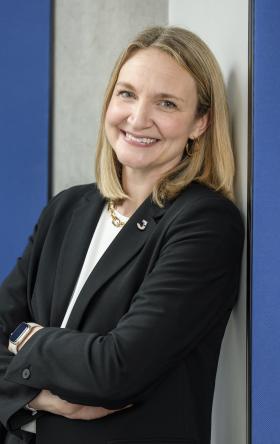A View on the Future of Rail & Transit: A Q&A with Gavin Fraser
Global rail & transit director talks modernizing New York City’s subway, decarbonization and more

Public transportation systems, valued as some of the most equitable and sustainable modes of transportation, connect communities and help stimulate economic development.
Expanding these complex systems and adding more advanced solutions, such as high-speed rail and decarbonization, to meet public demand can be an intricate, high-intensity ride.
Whether the journey includes keeping pace with capacity building and accelerating technology innovations, ensuring safety and security or maintaining transport networks, Jacobs is on board to serve all aspects of high‐speed and conventional passenger rail, freight and logistics, mass/public transit and innovative bus solutions. We’re a globally recognized leader in the safe and efficient delivery of rail and transit solutions – from planning, design and development to delivery and management.
In this Q&A, we connect with one of our teammates, Gavin Fraser, our global director of rail & transit, to talk about the trends and technologies on track to make an impact on rail & transit solutions of tomorrow.
Tell us a bit about what a day in the life is like as Jacobs Global Solutions Director for Rail & Transit, and what we offer to our clients in this area.
At their core, rail and transit systems provide connectivity. In my role, I focus on connecting our teams around the world, while providing our clients with the expertise they need, no matter where they’re located.
The connectivity we bring to our clients means we bring a diverse, global team of technical experts, advisors and practitioners who work collaboratively across all market sectors. We work throughout the infrastructure lifecycle from strategy, financing and economic advice, business case and planning advice, through to capital and operational delivery improvements across our client’s organizations. Our ability to provide real and robust, deliverable solutions and trusted advice leads to better, more certain outcomes and greater sustained value.
What are the biggest challenges in rail & transit today?
Rail and transit agencies are still facing significant challenges following the COVID-19 pandemic and its associated ridership loss. While there’s certainly been some bounce back, in some places like in North America, averages haven’t reached much beyond 60% of ridership prior to the pandemic due to the move to working from home. While other parts of the world are doing better, there’s still a global impact to the bottom line for these agencies.
To weather the storm, many agencies received significant government funding – but that’s now expiring. So, the next question is quickly becoming “Where is the money going to come from to keep operating?” On the capital project side, things are sometimes in better shape because of grants, but there are still significant challenges to keep the lights on and keep service running. Staying ahead of the curve means constantly honing vehicle and facility assets and putting technology and safety programs into practice that keep people on the move and enhance the rider experience.
Separately, as a society we face the need to rapidly reduce our carbon emissions, and while there are significant opportunities to improve rail and transit’s footprint here by moving away from reliance on diesel, there are barriers. The replacement technologies, be they battery, hydrogen or other, are still maturing, and today there’s no good solution for long distance services. Where the technology is more mature, for example with battery transit buses, supply chain maturity is the challenge to rapid deployment.
How do we help clients think differently to respond to the future?
Rail and transit is an interesting sector because it’s pretty well-established and much of the traditional work remains the same. Clients have been operating trains for more than 150 years and buses for more than 100 – and the fundamentals remain the same but changes in world around us demand different ways of thinking.
Our work covers the full cycle of rail and transit solutions – from planning, design and development to delivery and management and for all modes and rail and transit technologies, whether it’s a bridge or station design, payment collection system or vehicle engineering.
Because we work across not only rail and transit, but also water, energy and other markets, we’re able to help our clients consider what’s happening in the world around us and apply forward-thinking, cross-market solutions to move forward. For example, we’re able to bring in teammates from our energy team to guide clients on their decarbonization journeys – exploring the greening of fleets, electrification of rail whether through overhead wires or a third rail, or batteries or hydrogen.
You mentioned rail & transit fundamentals, like design, remaining the same, but industry trends causing us to think differently. Where do you see the industry heading?
The energy transition is a huge shift, not just in transportation but in every market. As more mandates and requirements come out to reduce emissions, we’re going to see the rise of new innovations and approaches to helping clients achieve their milestones. In transit, we’re seeing more clients looking to electrify their operations, particularly with bus fleets. While it’s currently easier to electrify a bus with a battery than it is a train – we can expect to see the rail sector, especially the non-electrified rail sector, coming on board to electrify and the need to scale. As I mentioned, there are significant constraints to both technology and supply chain which slow the roll out.
The digital transformation is another trend we’re seeing that’s not unique to rail & transit, but certainly is impacting where we’re headed. We’re seeing digital twins become a key part of operations. In the past, a client might maintain a bus every 10,000 miles, or a rail car at 90 days, for example, just because the manufacturer says they should. With a digital twin of their bus or rail infrastructure, they can instead monitor the system and conduct maintenance when it’s truly needed based on its real-time status. These insights give owners a true look at their system effectiveness and efficiency that previously just wasn’t possible – allowing them to proactively plan maintenance for less downtime and only when it’s needed, which saves them time and money. With agencies constantly asked to deliver more, with less, these insights are critical.
Is there a project you’re particularly proud of?
In New York City in the U.S., we’re working to improve the subway system by modernizing their fleet and signaling systems. A project I have worked with the Metropolitan Transportation Authority, New York City Transit for more than a decade is the R211 subway car fleet. We first won the contract to develop the train concept and then technical specifications for the next generation of New York City subway cars. Throughout this concept work, we really employed our global connectivity – for example bringing in capability from the U.K. to provide expertise on passenger flow modelling. Then, we successfully won the follow-on implementation phase. This project represents our largest vehicle contract in company history and it’s still ongoing. In fact, just earlier this year the first R211T open gangway subway cars came into service as a pilot, allowing riders to walk freely between subway cars without having to go through interior doors.
What I love about this project though is when I travel to New York, I get to see (and ride) these trains in service and carrying people. Most people don’t even notice it’s a new train, but some people go “Oh, this is cool. This is different," which is a testament to the work our global teams put into this project over the years. R211 is benefitting our client, it’s been a benefit to the growth of our team at Jacobs and it’s benefiting New York City as a whole.
There’s no feeling more fulfilling to me than seeing tangible projects like these out there in the world, moving people and serving their purpose.
About the interviewee

Gavin Fraser has more than 35 years of professional experience in rail vehicle engineering, design, testing, procurement, refurbishment, integration, and operation, focusing on overseeing vehicle procurement, rehabilitation and performance improvement projects. In addition to serving as Jacobs Global Solutions Director for Rail & Transit, Gavin leads our vehicle engineering team, with responsibility for overseeing and coordinating vehicle projects and resources, supporting project delivery and business development teams and ensuring excellence. Gavin provides strategic advice to clients for their rail vehicle fleet replacement and upgrade projects. Outside of work, he enjoys giving back by designing and building stage sets for a local youth theatre company, and serving on their Board.














































